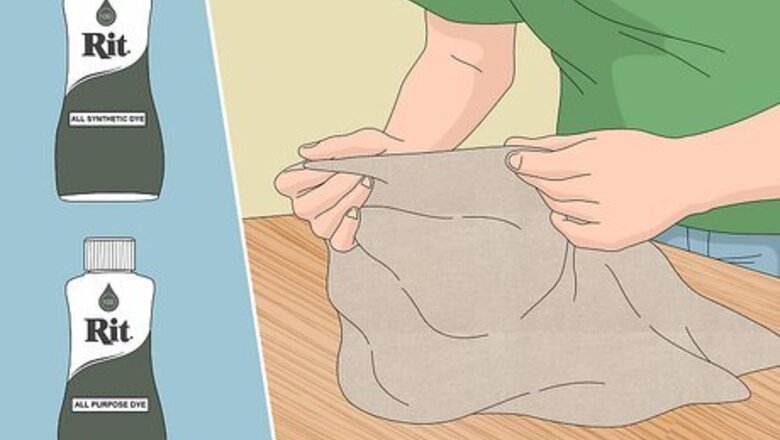
views
- Check the material you want to dye and weigh it to determine which dye to get and how much to use.
- For an easy method, fill a bucket with enough hot water that the fabric can move freely and is completely covered. Use 3 gallons (11 L) for each 1 pound (0.45 kg) of fabric.
- Pour the dye into the water, put the fabric into the water, and stir continuously for 10-60 minutes. Take the fabric out, rinse it with cool water, and wash it with mild detergent.
Prep & Dye Selection
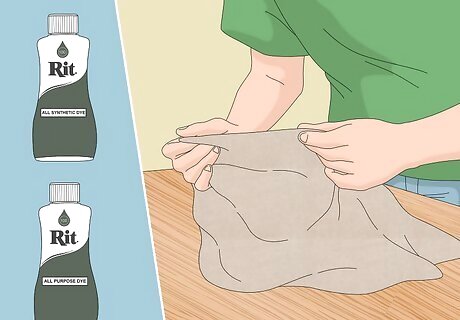
Check the fabric type you’re dyeing. Rit makes two kinds of dyes, one for natural fabrics and one for synthetic materials. If you’re dyeing cotton, linen, rayon, wool, silk, lamé, or nylon, get Rit All-Purpose Dye. If your fabric is more than 35% polyester, acrylic, or acetate, get Rit Synthetic Dye. For the best results, use white or off-white fabric. If you want to use a colored fabric, either remove the color using a product like Rit color remover, or choose a dye that mixes well with the color (for example, if you want to dye a yellow shirt orange, choose a red dye). Even if you remove the color, the patterns and logos will often stay in the fabric.
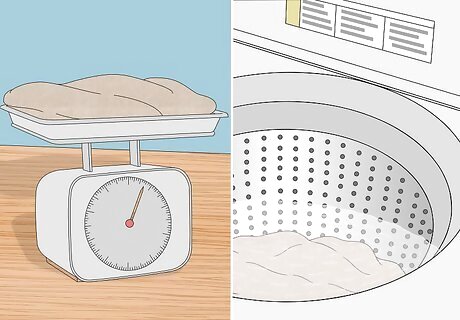
Weigh and wash your fabric. Before washing your fabric, weigh it on a kitchen scale. For every 2 pounds (0.91 kg) of fabric, use 1 bottle of liquid dye or 2 packets of powdered dye. Double the amount of dye if you want a darker color. Wash your fabric with a mild detergent, and remove any stains. Don’t use fabric softener while prewashing fabrics. Never dye dirty clothing, or the color can come out splotchy.

Protect your work area. Lay out a few sheets of newspaper or some old towels on the floors, countertops, and surfaces in your dyeing area. Rit dyes stain most materials, so by taking a few extra moments to prepare, you can spare yourself an extensive cleanup process. Wear gloves while handling dye to avoid staining your hands and to protect them from hot water.
Using a Sink or Bucket for Dyeing
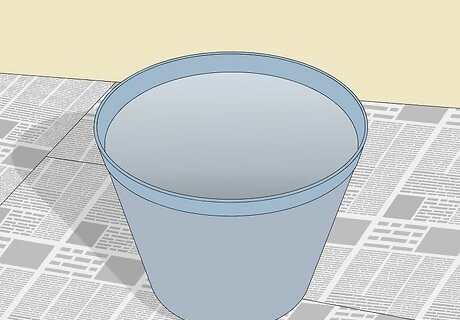
Set out a container to do your dyeing in. Get a container that can hold several gallons of water, plus whatever you’re dyeing. A plastic bucket or dish pan that holds around 5 gallons (19 L) is often large enough for your fabric to move freely. You can also do your dyeing in a sink, provided that it’s stainless steel. Don’t use Rit Dye in white porcelain or fiberglass sinks, as it can leave permanent stains.
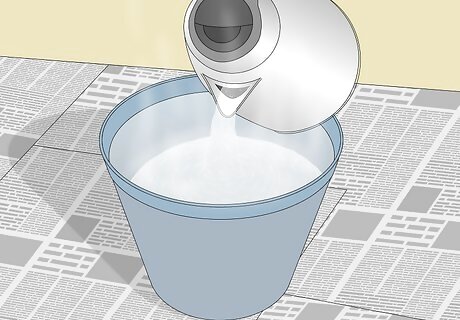
Fill the container with hot water. For effective dyeing, use water around 140 °F (60 °C) (hot enough to release steam). The intense heat softens the fibers of the fabric and helps them accept the dye. If your tap doesn’t get hot enough, heat the water on the stove. Use 3 gallons (11 L) for each 1 pound (0.45 kg) of fabric.
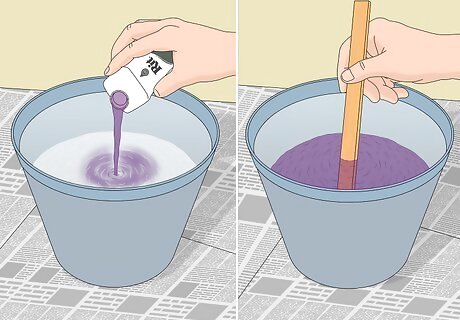
Stir the dye into the water. Pour 1 bottle of liquid dye per 2 pounds (0.91 kg) of fabric. For powdered Rit Dye, mix 2 packages into 2 cups (470 mL) of hot water, then incorporate the mixture slowly until you achieve the desired depth of color. Stir the dye until it’s completely distributed. Shake liquid dye before adding it to the water. Stir with a stainless steel spoon or similar utensil. If you’re dyeing a single t-shirt or a couple of pairs of underwear, you can use less dye, whereas you’ll likely need more for a heavy sweater or multiple pairs of jeans.
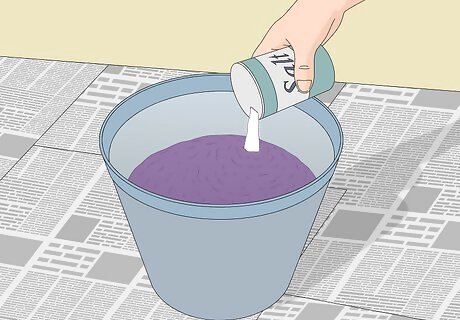
Add salt or vinegar for even dyeing. If the item you’re dyeing is cotton, dissolve 1 cup (300g) of salt into 2 cups (470 mL) of hot water and add it to the dye bath. For wools, silks, or nylons, use 1 cup (240 mL) of distilled white vinegar instead. Stir the dye bath once again to disperse the additives. Some fabrics tend to resist dyes. The salt or vinegar will serve to condition the fabric and promote consistent coloration. Adding 1 teaspoon (4.9 mL) of dish soap also helps to evenly distribute the dye.

Perform a color test on an absorbent paper towel. Dip the corner of the paper towel into the solution and note the color. If it’s too light, add more dye. If it’s too dark, add more water. Repeat your color test on another part of the paper towel as many times as necessary until you get the color just right.
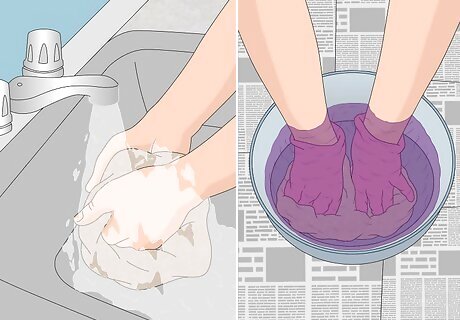
Wet your fabric and submerge it in the dye. Wetting your fabric beforehand helps the dye penetrate the fibers more easily. Wring out your fabric and slowly lower it into the bath. Make sure the entire piece sits below the surface of the dye. Keep the fabric as unfurled as possible when you put it into the dye to prevent lines from forming in the color.
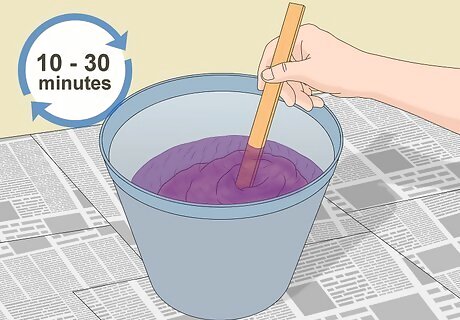
Stir the dye bath for 10 minutes to 1 hour. Stir the water with a spoon or drag the garment around with a pair of tongs. Keep the garment moving constantly so that every part of the fabric is exposed to the solution. The longer you leave it in the dye bath, the more intense the final color will be. Stir diligently for the first 10 minutes, since they are the most important for allowing the dye to absorb. Nylon dyes very quickly, so take it out after 10 minutes. Cotton polyester blends take at least 30 minutes to fully dye. If you use tongs, switch up where you hold the fabric to allow every part to touch the dye. Colors appear darker when the garment is wet.

Remove the dyed garment and rinse it off. When you're satisfied with the look of the item, take hold of one corner with your tongs and lift it out of the dye bath. Wring out as much dye as you can by hand, then rinse it with cool water. To avoid leaving a colorful trail of drips all over your home, set up your dyeing station close to the area where you'll be doing your rinsing.
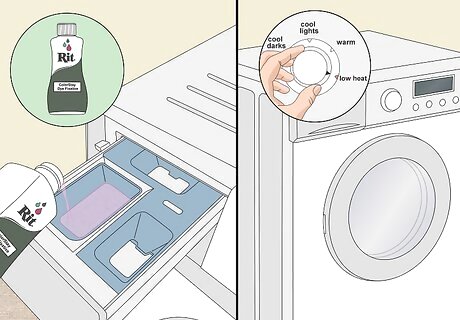
Lock the dye in or wash it on low heat. Use Rit ColorStay Dye Fixative or use a DIY dye setting technique to lock in the dye, then wash the fabric on low heat with a mild detergent. Dry the item on a high setting to further lock in the color. Some materials may fade a little following a few washings, so consider using color-preserving detergents and fabric softeners to maintain the appearance of your dyed clothing. Wash the fabric with like colors and old towels to prevent bleeding. Hand wash and dry delicates, like wool, silk, and lace in a sink full of clean, warm water. Press out the excess water gently, then hang each garment separately and allow them to air dry.
Using the Stovetop Method to Dye Synthetic Fabrics
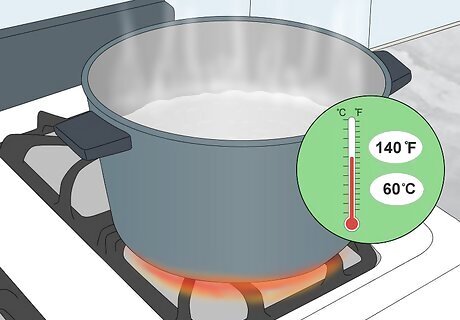
Heat a large pot of water on the stove. Choose a stainless steel pot that’s large enough to hold at least 3 gallons (11 L) for each 1 pound (0.45 kg) of fabric you’re dying. Turn on your stove and get the water to 200 °F (93 °C), or to where it’s just simmering. The stovetop method is great for getting more vibrant colors with natural fabrics, however, it is the only method you can use for synthetic fabrics. If you’re dyeing natural fabrics, you can have the temperature as low as 140 °F (60 °C). Wear rubber gloves to protect your hands from the heat.
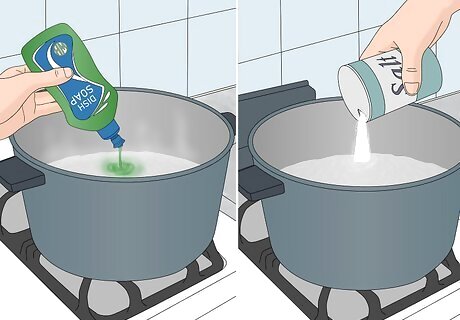
Add dish soap to the water and vinegar or salt for natural fabrics. Add 1 teaspoon (4.9 mL) to the water to help the dye spread evenly. If you’re dying cotton, rayon, ramie, or linen, add one cup (300 g) of salt to the water. If you’re dying nylon, silk, or wool, add 1 cup (240 mL) of vinegar to the mix.
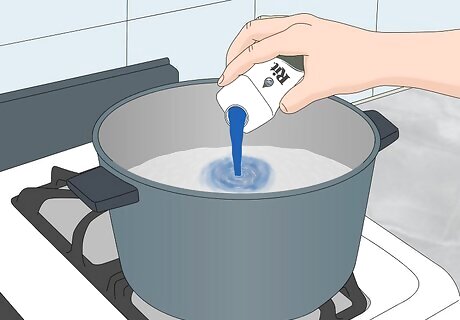
Mix the dye into the bath. Add 1 well-shaken bottle of liquid dye or 2 packets of powder for every 2 pounds (0.91 kg) of fabric you’re dyeing. Stir until the dye is completely dissolved. Add more dye for darker colors.
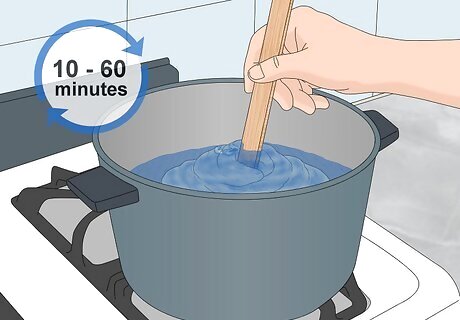
Add the fabric and stir continuously for 10-60 minutes. Wet and wring out the fabrics you want to dye, then add them to the bath. Stir the fabric so all parts evenly come in contact with the dye. The first 10 minutes are crucial for letting the dye absorb into the fabric, so stir diligently! Keep the water at a low simmer the entire time. Keep polyester cotton blends in the bath for at least 30 minutes, and take nylon out after 10 minutes.
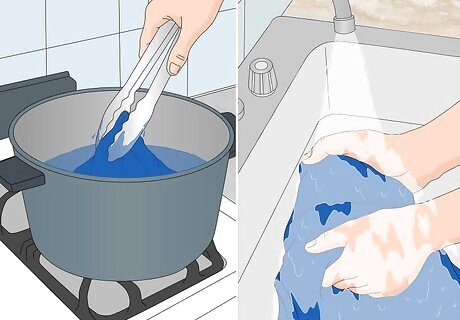
Take out the fabric and rinse it with warm, then cool, water. Once your fabric has reached your desired color (wet fabrics will look darker), take it out of the pot and wring out the excess water. Rinse it in warm water and slowly switch to cool. Stop once the water runs clear.
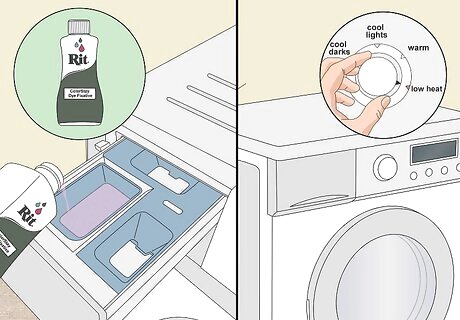
Wash your fabric on low heat with a mild detergent. If you dyed fabric with cotton, linen, ramie, or rayon, use Rit ColorStay Dye Fixative, or use a DIY method to set the color. Wash the fabric with like colors and a mild detergent on a low heat setting, then dry it on hot.
Using a Front-Load Washing Machine to Dye Fabric
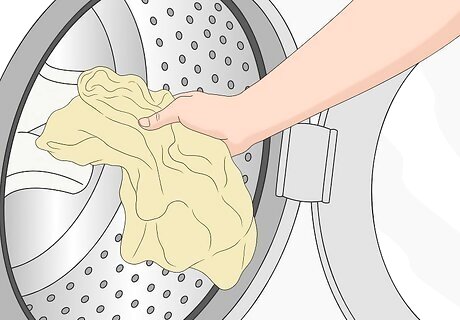
Put in your fabric and set the washer to hot. Wet your fabrics and put them into the barrel, then turn your washer to its hottest setting. Set the wash cycle to be at least 30 minutes (before the rinse cycle). Only dye a few, lightweight items at a time in front load washers. For large batch dyeing and bulky items, use the stovetop or bucket method.
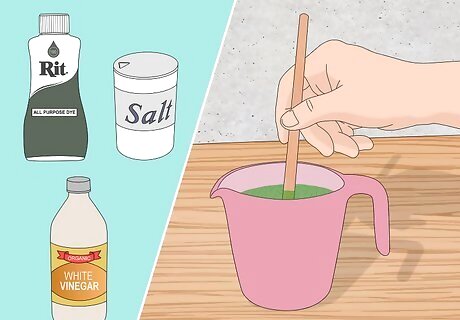
Mix the dye and vinegar or salt with hot water. Mix enough powder or liquid dye for the amount of fabric you’re dyeing with 4 cups (0.95 L) of very hot water. In a separate container, mix 1 cup (300g) of salt or 1 cup (240 mL) of vinegar with 4 cups (0.95 L) of hot water. Mix 1 teaspoon (4.9 mL) dish soap in with the salt or vinegar. Use salt for cotton, linen, rayon, or ramie, and vinegar for silk or nylon. Wear rubber gloves to protect your hands.
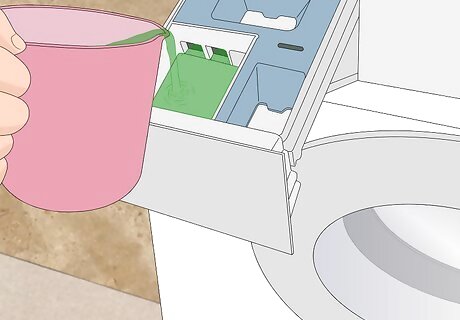
Start the cycle and add your dye and other liquid. Once the cycle has started, take out the dish detergent tray and pour in the dye. Next, pour in the vinegar or salt, then flush the tray with 4 cups (0.95 L) of hot water.
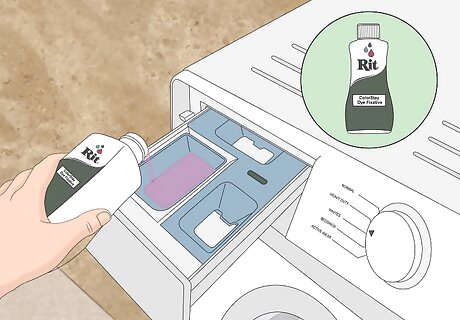
Set the color and wash the items again when the cycle is complete. Once the cycle is done, use Rit ColorStay Dye Fixative or try a DIY method to extend the life of the color, or immediately wash the fabric again in warm water with a mild detergent. Dry the items on the hottest setting the fiber type can handle.
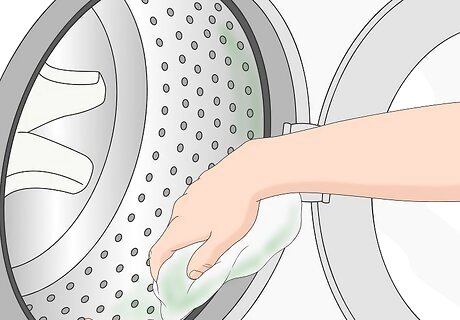
Clean your washing machine with bleach. Wipe down the inside of the lid and all of the plastic parts of your machine. Pour a small amount of bleach into the internal dispenser (if you have one), then put a few old towels and 2 cups (470 mL) of bleach into the barrel and run a cycle on the largest load and hottest water setting.
Using a Top-Loading Washing Machine to Dye Fabric
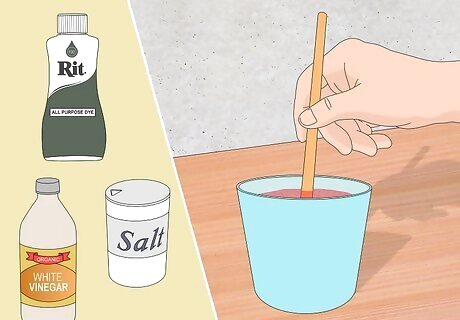
Dilute the dye and vinegar or salt in water. Pour 1 container of liquid dye into 4 cups (0.95 L) of hot water, or 2 packets of powdered dye in 2 cups (470 mL) of hot water. If you’re dyeing cotton, linen, rayon, or ramie, mix 1 cup (300g) of salt with 4 cups (0.95 L) of hot water, or use 1 cup (240 mL) of vinegar if you’re dyeing silk or nylon. Use the correct amount of dye for the weight of your items. Wear rubber gloves for the entire dyeing process.

Add the dye, salt or vinegar, dish soap, and clothes to the machine. Pour all the liquids, as well as 1 teaspoon (4.9 mL) of dish soap into the barrel. Wet the items you’re dyeing and add them in, too.
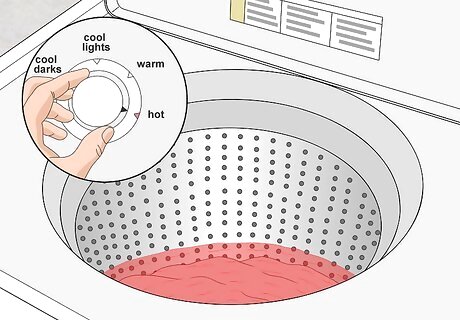
Set the washer to hot and start the cycle. Make sure the wash cycle lasts at least 30 minutes before the rinse cycle starts. You may have to stop and restart the cycle if your washer doesn’t have an extended setting. If you’re washing bulky items (drapes, sheets, slipcovers) periodically stop the wash to untangle everything.
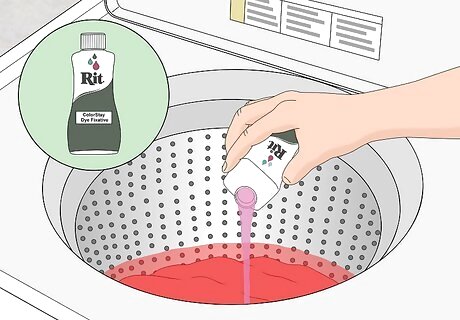
Rewash the items, or set the color with a dye setter. Use Rit ColorStay Dye Fixative or try a DIY method to lock in the color, or immediately rewash the fabric in warm water with a mild detergent. Dry the items afterward.
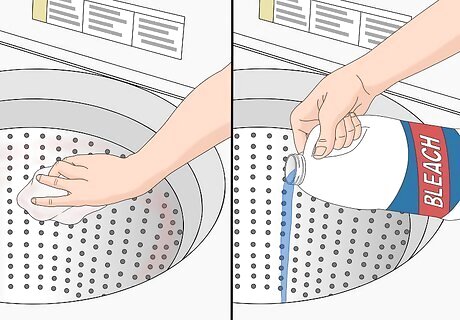
Clean out your washer to prevent stains. Wipe the inside of the lid and pour bleach into the internal dispenser, if you have one. Fill the washing machine as high as it can with hot water, then add detergent and 2 cups (470 mL) of bleach and wash 3 old towels in it.




















Comments
0 comment